Holden Sitting Up on a Hill Easy Drawing of Little Hills
The U.S. 2nd Ranger Battalion held Hill 400 in the embattled Hürtgen Forest against five fierce German counterattacks in December 1944.
By James Marino
Mired in combat during the Battle of Hürtgen Forest of Germany, an American soldier wrote in December 5, 1944: "The road to the front led straight and muddy brown between the billowing greenery of the broken topless firs, and in the jeeps that were coming back they were bringing the still living. The still living were sitting in the back seats and some were perched on the back seats and others were sitting facing forward on the radiators because the jeeps were that crowded. You could see the white of their hasty bandages from far off and there were others of the still living who were on stretchers strung from the front seats to the back and on the radiators too, and the brown blankets came up to their chins. Overhead the sky was grey."
The Battle of Hürtgen Forest: Why Hemingway Called it "Passchendaele With Tree Bursts"
The area surrounding the Battle of Hürtgen Forest encompassed about 50 square miles of rugged, densely wooded terrain along the German-Belgian border south of Aachen, the first major German city to fall to the Allies. The area was thickly laced with mines, barbed wire, and concealed pillboxes with interlocking fields of fire. The American First Army was tasked with capturing the forest to secure the right flank of the advancing VII Corps, to prevent the Germans from mounting counterattacks from its concealment, and to attack a large portion of the Germans' fixed fortifications of the Siegfried Line from the rear.
The dominant geographic feature in the Hürtgen was near Bergstein, the Burgeberg-Castle Hill, or as the Americans called it, Hill 400 because of its height in meters, equivalent to 1,312 feet. Its steepest slope was at a 45-degree angle, and the hill was thickly wooded with evergreens. From this promontory the Germans enjoyed a commanding view of American movements and directed both nasty artillery fire and counterattacks. No American vehicle or foot movement went undetected from this vantage point. It was the cornerstone of the German line. If the Americans seized Hill 400, it would provide excellent observation of the Roer River, the next Allied objective after Hürtgen was cleared of Germans.
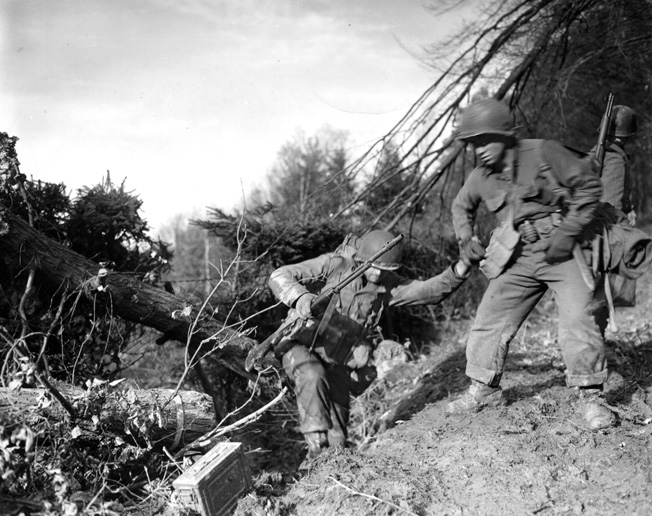
The U.S. 9th Infantry Division made the first offensive move into the Hürtgen in September 1944 and was still there by the middle of October, having gained three kilometers at the cost of 4,500 casualties. A new attack was launched in November by the 28th Infantry Division. No appreciable ground was gained, and 6,184 Americans were casualties. The 4th Infantry Division was committed at the end of the month. After sustaining 6,053 casualties, it was relieved by the 8th Infantry Division early in December. In his book The Mighty Endeavor, Charles MacDonald described the fighting in the Battle of Hürtgen Forest as "the battle of the hedgerows all over again only this time with freezing rain, sleet, snow, flood, mud, pillboxes, and dense woods straight out of frightening German folk tales. It was the Argonne of World War II."
War correspondent and famed author Ernest Hemingway was more succinct: "Passchendaele with tree bursts."
"The Purest Hell I've Ever Been Through"
The men of the 2nd Ranger Battalion, veterans of D-Day who had landed on Omaha Beach and some of whom had scaled Pointe-du-Hoc, were attached to the VII Corps and became caught up in the attrition of forest combat. Prior to this, the battalion had remained in Normandy to perform a series of odd jobs. When VII Corps began its drive into Brittany, the Rangers were ordered in as well. The battalion helped capture the great port city of Brest, and after a two-month respite, the battle-hardened soldiers joined the offensive against the Siegfried Line. On November 14, the 2nd Rangers, attached to the 28th Infantry Division, moved into the front line with a complement of 485 enlisted men and 27 officers.
General Norman Cota, commander of the 28th Division, who had personally seen the Rangers in combat on Omaha Beach, used the 2nd Ranger Battalion to replace units of the 112th Infantry Regiment on the front line. Lieutenant Bob Edlin of A Company walked his platoon through the snow and ankle-deep mud to the village of Geremeter. There the Rangers met the infantry of the 112th.
Edlin recalled, "The infantry outfit that had been up there was actually almost running in retreat just to get away. I ran into a friend in that unit, Captain Preston Jackson, who said, 'Bob this is the meanest son of a bitch that you've ever seen in your life up there. I wish you wouldn't go.'"
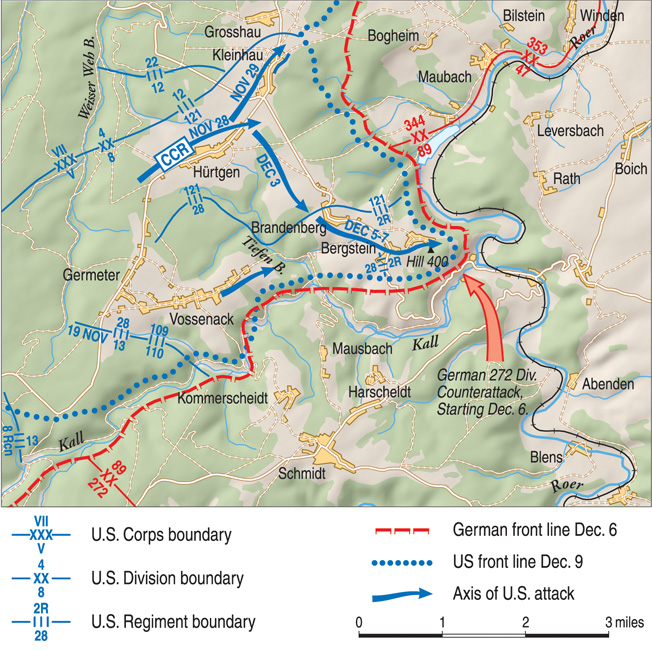
The Rangers did go and were immediately greeted with their first but not their last German artillery barrage. "Suddenly the artillery came. It's the purest hell I've ever been through. It was just round after round of crashing and smashing, beating on your head till you think there is no way you can stand it," recalled Edlin.
The most shocking surprise to the Rangers was not the enemy but the Americans. Captain Sid Solomon noted his men's observations. "The Rangers of Baker Company were amazed to see the GI equipment, clothing, and even weapons that had been discarded by the division troops who had previously held this area. Cold weather and a driving rain did not help the morale of those inexperienced American troops."
Even more disturbing was the fact that the regiment left wounded behind. Frank South, a medic with the 2nd Ranger Battalion, recounted the discovery. "We moved to what had been a German troop shelter at the crossroads near Vossenack. When we entered the troop shelter, we medics were shocked to find several wounded Americans there. In addition to abandoning equipment and supplies along the road, the 112th Infantry Regiment deserted some of their own wounded in their haste to retreat. Of course, we took care of their injuries and immediately evacuated them."
The Rangers ran patrols, dug in deeper, reinforced their foxholes with logs, and battled the cold weather. Fortunately, direct intervention by the Supreme Allied Commander, General Dwight D. Eisenhower, helped the 2nd Rangers to be better prepared for the cold weather than most of the regular infantry in the Hürtgen. Bob Edlin explained, "While at the bivouac, we were visited by General Eisenhower. The whole battalion gathered around and he just flat-out asked if anybody could tell him why we didn't have the new boot packs. One of the men yelled out, 'Hell, General, everybody back at headquarters has got them,' which was true. Everybody at Army, corps, and divisional headquarters was wearing boot packs, parkas, and warm clothes. That gear never leaked down to the front lines. We were still wearing summer clothes and it was in the low thirties. General Eisenhower said that will be taken care of, and God rest his soul, it was. A few days later we received boot packs, and even wristwatches. He must have raided the whole damn headquarters to get enough for one Ranger battalion."
Rangers Under V Corps
Near the end of November, the 28th Division relinquished its frontline sector to the 8th Infantry Division, V Corps. The Rangers remained and supported the 8th, but were now under V Corps command. After the 8th Division moved into the line, the Rangers moved Companies C, D, E, and F a short distance behind the front. A and B Companies remained deployed on the extreme right flank of the division's 121st Infantry Regiment.
Lieutenant James Eikner, in charge of headquarters communication, explained how the men felt. "We were a specialized unit, all volunteers. Putting us in a defensive position wasn't utilizing our skills and capabilities. Just sitting in those foxholes. We were very disappointed about this."

All three infantry divisions, 9th, 28th, and 8th, had tried to seize Hill 400 but failed. A combat command of the 5th Armored Division tried in the first week of December. Despite armored support, its infantry was also repulsed. The 47th Armored Infantry Battalion barely held Bergstein against German counterattacks and was in no shape to participate in another attack on Hill 400.
Positioning to Take Hill 400
General Walter Weaver, commander of the 8th Division, personally asked the V Corps commander, General Leonard Gerow, for Rangers to bolster the armored combat command in Bergstein and to assist his division's next assault on Hill 400. Gerow, with approval from General Courtney Hodges, commander of the First Army, released the 2nd Rangers from V Corps control and trucked them from their bivouac to Hill 400. Weaver then decided to let the Rangers assault the hill by themselves, so as to keep his division fresh and to allow the Rangers to work in their own manner.
That same day, Lt. Col. James Rudder, the battalion commander, was transferred to the 28th Division's 109th Regiment. Captain George S. Williams, the executive officer, and Captain Harvey Cook, the intelligence officer, were called to 8th Division headquarters and given the mission. They were to relieve elements of Combat Command Reserve (CCR), 5th Armored Division, outside the town and take Hill 400. Captain George S. Williams, promoted to major, assumed command of the tactical effort.
Major Williams returned to the Ranger assembly area at 2130 hours. Trucks carried the Rangers toward the town of Kleinhau. The trucks were dispersed and "we had a heck of a time getting them together," recalled Williams. From Kleinhau the companies began their march to Bergstein. Shortly before the move, Lt. Col. Rudder hustled back from First Army headquarters to help Williams as much as possible, and Williams proceeded to Brandenberg.
The Rangers marched through darkness, mud, and bone-chilling cold to reach Bergstein before dawn. At Brandenberg, Major Williams contacted Colonel Glen Anderson, the CCR commander. Anderson outlined the difficulties his unit had faced at Bergstein and gave the group a guide to the armored infantry company command post in the town.
Captain Harold K. Slater went to the western edge of town to contact elements of the 5th Armored Division. By this time Companies A, B, and C had arrived. They went on through without stopping to take up defensive positions to the west and south of Bergstein. There were no troops in these positions until their arrival. The men of the 5th Armored were all in cellars, and they provided no guides. Fortunately, the 2nd Rangers had three lieutenants working as advanced liaison officers. These men were briefed at the armored command post on the locations of enemy positions. The lieutenants helped the battalion move into its positions by 0300 hours. Three companies, A, B, and C, dug in on the edge of a wood near the base of the hill. Between 0300 and 0500, Companies D, E, and F settled into Bergstein.
Rudder's Assault Plan
Rudder devised the assault plan before the Rangers left the bivouac. The men were confident in it because it was Rudder's concept. Companies D and F would assault Hill 400, while Companies A, B, and C secured nearby ridges, established roadblocks, and provided supplemental mortar fire. Company E and the tanks of CCR remained in Bergstein as the reserve to support the assault or to respond to the expected German counterattack. A small scout party from Companies D and F reconnoitered the hill before the assault. Lieutenant Len Lomell took out the patrol from Company D.
Lomell recalled, "The patrol was to discover evidence of pillboxes, bunkers, and enemy positions. I set out with my patrol at 0330 and returned with the information to the battalion forward CP at 0600."
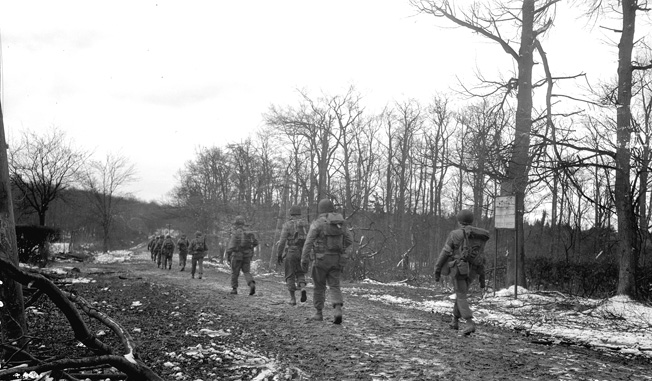
Headquarters reviewed the information and passed it to the assault companies. The plan still called for E Company to be the reserve while D and F Companies, the assault force, assembled near the church and cemetery in a partially sunken road that paralleled the base of Hill 400. The assault was at 0730 sharp. Williams called for the opening salvo just before sunrise.
The Assault Begins
The quick, crisp barrage caught the Germans by surprise. At dawn, Williams launched two companies across an open field and up the heights, using one company's covering fire to support the attack. Companies D and F, a total of 65 Rangers, moved out from their positions in Bergstein and crossed the line of departure at 0730.
German troops of the 272nd Volksgrenadier Division reacted like veterans, scrambling to their positions despite being under the American artillery barrage. Sid Salomon, commanding B Company, observed the German response. "The enemy defenders immediately became alert. A red flare shot in the air from an enemy outpost. Shortly thereafter, a heavy mortar and artillery barrage came down on the assaulting Rangers. Heavy small arms and machine gun fire was directed on the rushing Rangers. Casualties on both sides began to mount. A creeping German artillery barrage behind the assaulting Rangers produced more Ranger casualties. The enemy offered stiff resistance."
Four machine guns fired point blank at the Rangers moving up the hill. A German observation post swung into action, directing accurate mortar and artillery fire. Williams wrote in his after action report, "The Germans poured in mortar, 88, 120, and self-propelled gun fire."
Company C fired in support of the charge as its companions crossed the field. Salomon described the opening moments of the Ranger advance: "The CO at the appropriate time gave the word 'Go!' With whooping and hollering as loud as possible, firing clips of ammo at random from their weapons in the direction of the hill, the Rangers ran as fast as they could across the approximately 100 yards of open, cleared field into the machine-gun and small-arms fire of the German defenders. Crossing the field, and before reaching the base of the hill, the company commander and his runner became casualties, but undaunted, the remaining D Company Rangers charged up the hill."
Lieutenant Lomell described the opening moments of his first platoon's action. "The platoon crossed the 100 yards of half frozen mud, shooting randomly, we were at a dead run, facing small arms fire."
Salomon and Lomell did not know what really triggered the assault. Staff Sergeant Bill "L Rod" Petty of F Company did.
"During the wait for the jump-off enemy mortars burst about 75 yards behind us and moved toward us," Petty recalled. "You could feel the tension building as voices grumbled about why we didn't charge. We were stuck waiting for our own artillery to lift. We knew the enemy mortars would reach us before our barrage lifted. We were caught in a 200 yard area between the barrages. A new officer ordered a scout forward. McHugh and I screamed at the GI not to listen to the order. Private Bouchard stood. Four steps later he was cut down. This shot was the fuse that ignited the explosion of the Ranger charge. I was pulling Bouchard back when I heard McHugh yell, 'Let's go get the bastards!' Waving his Tommy gun over his head, he broke across the field. As one man, F Company with bayonets shining, hip firing, and yelling a battle cry that probably goes back into the eons of time charged into the jaws of death. I never saw a more brave and glorious sight. It was a moment of being proud to be a Ranger."
"Hi-Ho Silver!"
Not all Rangers felt enthralled by what was happening. Herman Stein, also of F Company, had more basic thoughts. "I wasn't thinking about a … thing. My one thought was, 'Let me get the hell across this field into some woods over there.'"
In his book Citizen Soldiers, author Stephen Ambrose related the Rangers' comparison of Point-du-Hoc and Hill 400, "Those who were at Pointe-du-Hoc on D-Day recall Hill 400 as worse. It was not as precipitous, but it was rocky shale, with frost and snow on it, and they had no grappling hooks or ropes. It was hand-over-hand, using the third hand to keep up a stream of fire."
Bud Potratz, D Company, was part of the whirlwind of combat edging up the hill. He remembered, "Fox Company led the way followed by the 1st and 2nd sections of the 1st Platoon of Dog Company. We fell to the ground at the sunken road and began firing our rifles toward the two burned-out buildings in front of the D Company attack. Mortar shells fell all around us, and our guys were getting hit. Captain Otto Masney, commander of F Company, gave the order to fix bayonets, and suddenly Mike Sharik stood up and yelled, 'C'mon, you unholy bastards!' and off we went. I remember firing at the hip and hollering 'Hi-Ho Silver!' as we trotted across the open field toward the base of the hill."
Salomon could also see F Company moving up the hill into enemy strongpoints. "An enemy machine gun located at the left lower corner of the hill wounded and killed several of the F Company Rangers as they crossed the open field," he recalled. "The remainder of the company continued forward, some running faster than others, all firing their weapons running up the hill…. Some of the Germans at the lower base of the hill either turned and ran up the hill to avoid the charging Rangers or stood up and surrendered."
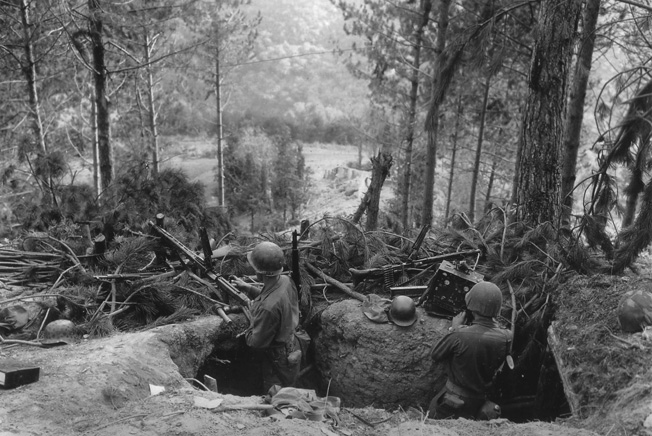
Herman Stein figured the Germans saw it this way. "Half the Krauts ran and half gave up. I guess if you see 120 men acting like a bunch of Indians coming at you, you think these guys are nuts! We were yelling like crazy—rebel yells."
Private William Anderson, a seasoned Ranger broken from sergeant to the lowest rank for garrison infractions; Sergeant Petty, and Pfc. Cloise Manning were the first F Company men to reach the summit of Hill 400. They saw an enemy bunker with steel doors on the crest. Petty thrust his Browning Automatic Rifle (BAR) into an aperture and emptied a 20-round magazine. Anderson shoved in a couple of grenades. Just then, an enemy shell exploded, killing Anderson.
Captain Masney arrived with more soldiers and captured the bunker. According to Lomell, Sergeant Harvey Koenig's squad chased the remaining Germans down the hill, almost to the Roer River, before returning to deploy along the forward crest. By 0835 the 2nd Rangers held the hill and had captured 28 prisoners.
The German Barrage
The Rangers knew the Germans would follow with an immediate counterattack. Quick preparation and placement of the men had to be achieved. The men of D and F Companies found it difficult to dig foxholes in the rocky ground.
Both sides recognized the tactical importance of Hill 400. The Germans threw in the crack 6th Parachute Regiment to counterattack. According to captured German records, Field Marshal Walter Model had offered Iron Crosses and a two-week furlough to any Germans who recaptured the hill.
German artillery peppered Hill 400. The bursts showered the Rangers with deadly shrapnel. The shale prevented them from digging in, but the bunkers provided some cover. Potratz remembered, "Shells hit the hill from three sides. We could hear our comrades trying to dig in. There were screams of dying men. The smoke burned our eyes and nostrils. It was horrific, and the voices of the wounded tore our hearts."
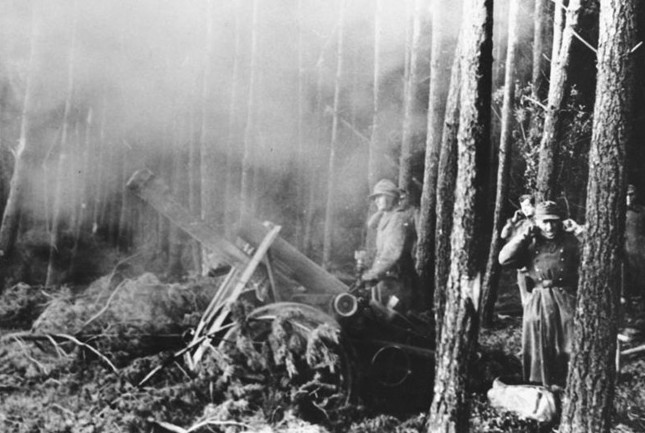
The barrage cost casualties in more than one way. In his book Closing with the Enemy, historian Michael Doubler reported the psychological impact. "One new replacement in the 2nd Rangers saw the head of a fellow ranger less than three feet away blown completely off. The new soldier became speechless, did not know his name, and could not recognize anyone around him. The Rangers evacuated the replacement off the hill between counter-attacks. He ended up in a stateside psychiatric ward."
The Rangers were too weak to hold all points along the line simultaneously. Lomell had to learn where the Germans were building strength to attack. He boldly sent out two-man recon patrols to check likely enemy assembly areas down the hill. With the intelligence the patrols gathered, Lomell was able to meet each thrust with the little strength he had. As a result, Hill 400 was saved by brains and bravery at the junior level.
Staff Sergeant Petty, in charge of what was left of F Company, organized his defense on top of the hill. Herman Stein took the 1st and 2nd Platoons and set up near the bottom of the hill toward the river. "I am convinced that these six to eight men were the vital factor that kept 'F' from being overrun," claimed Petty afterward. He was right; the Germans focused their efforts on that day entirely on F Company in an attempt to recover the bunker.
Outnumbered 10 to One
The first of five German counterattacks during the next two days hit the Rangers at 0930. In each assault the German force numbered between 100 and 150 men. Most of the attacks developed from the south and east where wooded areas close to the hill's base allowed a company of German paratroopers to launch the assault.
Major Williams described one of the counterattacks. "Germans were in and around the bunker on the hill before the Rangers were aware of their presence. Once on the hill they attempted to rush the positions. They used machine guns, burp guns, rifles, and threw potato masher grenades. Hand-to-hand fights developed on top of the hill in which some use was made of bayonets."
Petty was wounded in the fight and was evacuated that night. The Rangers held, forcing the Germans to regroup. The enemy artillery did not let up.

By noon, two of the Ranger companies mustered only 32 men. The survivors of D Company lost their commanding officer just before the German counterattacks began. Captain Masney was captured attempting to move down the hill to bring up more reinforcements. Lomell was the sole officer of D Company still standing. Lomell was also wounded, his left index finger almost severed and bleeding from the ears from the concussions of the artillery barrage.
General Weaver was unable to disengage any troops to relieve the Ranger Battalion. Stuck on the hill, the Rangers threw back every German counterattack over the next 40 hours.
The German paratroopers launched the second counterattack at mid-afternoon as about 150 men struck F Company. Ranger casualties increased. Lomell recalled, "We were outnumbered 10 to one. We had no protection, continuous tons of shrapnel falling upon us, hundred of rounds coming in."
18 Battalions of Artillery
German efforts were about to pay off when a single Ranger turned the tide. Lomell recalled the moment. "My platoon sergeant, Ed Secor, a very quiet man, out of ammo and unarmed, seized two machine pistols from wounded Germans and in desperation charged a large German patrol, firing and screaming at them. His few remaining men rallied to the cause, and together they drove the Germans back down the hill."
By 1600 hours, the Rangers had only 25 men left on top of Hill 400. "We had stopped another counterattack, but if the Germans had known how many men or really how few we had up there, they would have kept coming," reflected Lomell.
The desperate situation seemed to be sensed back at Ranger headquarters in Bergstein. Major Williams dispatched urgent messages to General Weaver for reinforcements, but none were available. Williams scraped together a platoon of 10 men from E Company in Bergstein and sent them scampering up the hill. The unit arrived in the nick of time just as the third counterattack erupted. The Germans struck with both of their regrouped companies.
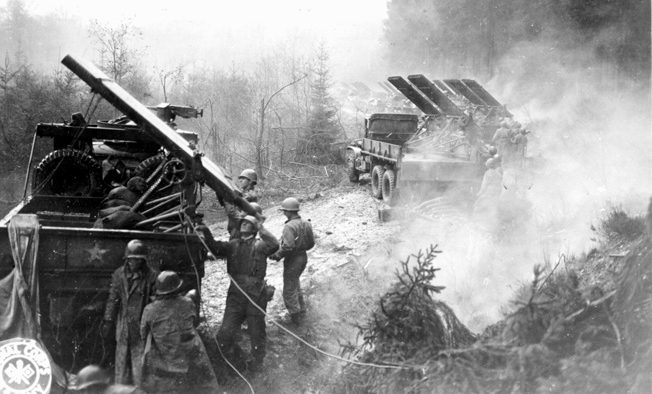
holding the positions of the 2nd Ranger Battalion on Hill 400.
American artillery was the key to the repulse of the third German counterattack. More precisely, it was one American forward observer, 1st Lt. Howard K. Kettlehut, from CCR's 56th Armored Field Artillery Battalion. He had a clear 360-degree field of vision atop the hill. As the German wave crested the hill from three directions, Kettlehut brought down the American firepower.
"At one point Kettlehut brought down fire from all artillery available in the Corps—18 battalions in all: 155s, 75s, self-propelled, 8-inch and 240mm guns placed a ring of explosive shells around the hill," remembered an observer. Kettlehut directed the barrage to keep the German paratroopers out of the hilltop positions and to prevent further reinforcements from the woods. This counterattack, together with another at 1500 hours, was beaten back.
"It was a Death Factory"
The evacuation of the wounded was difficult during the fight. The first aid station in the bunker held as many as 20 wounded at a time. When night fell, ammunition bearers clambered over the snow, ice, and rocks up to the top and returned carrying the wounded on litters. Around 2100 hours, several men from E and C Companies performed the duty. Medic John Worthman recalled the arduous process of moving the wounded. "Most wounded had to be carried back to the aid station on litters. Carrying litters is cruel work in good terrain and inhuman punishment on wet hillsides under tree bursts."
Litter jeeps were waiting at the bottom of the hill. Nearly every jeep in the battalion was used for the evacuation. The battalion physician, Captain Walter E. Block, taught his medics never to hesitate to go in harm's way to care for a Ranger. Block was killed while tending the wounded and coordinating the evacuation when a shell burst on the roof of the aid station.
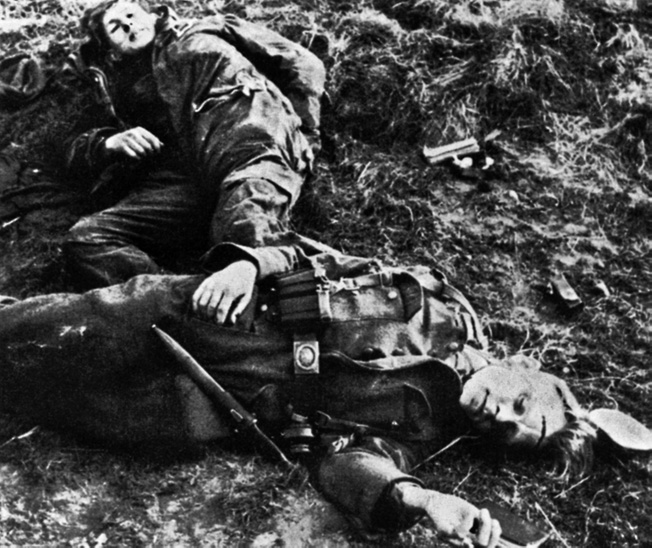
Throughout the night the Germans shelled the Rangers. "We stayed out all night," Stein said later. "There was a sort of drizzle. At that point we had about six guys from F Company left. One of these men included a replacement, Julian Hanahan, who fought like a veteran. We had a few guys down below, at the base of the hill."
Lomell summed up the entire first day on Hill 400. "It was a death factory. One way or another, they got you. You froze to death or you got sick or you got blown to bits. June 6, 1944, was not my longest day. December 7, 1944, was my longest and most miserable day on earth during my past 75 years."
The Last Counterattacks
Just after dawn on December 8, E Company reported being counterattacked from the north by troops coming from Obermaubach. The German 6th Parachute Regiment probed the hill under the cover of artillery fire. At 0808 friendly artillery fire, which was already on the way, was requested on the road to the north. It proved effective, and the Germans withdrew. Kettlehut and the artillery easily handled the morning attack.
Captain Arnold recalled the most difficult attack of the 8th. "The heaviest counterattack of the fight was launched at 1500 on December 8. Between 100 and 150 men supported by direct fire of the 88s, self-propelled guns, mortars, and artillery attacked from all sides. Five of them [German soldiers] got within 100 yards of the church which was being used as a first aid station. Artillery fell all around the aid station, one round entering one window and leaving through another, taking away part of the second window. This attack lasted two to three hours and was beaten back by artillery."
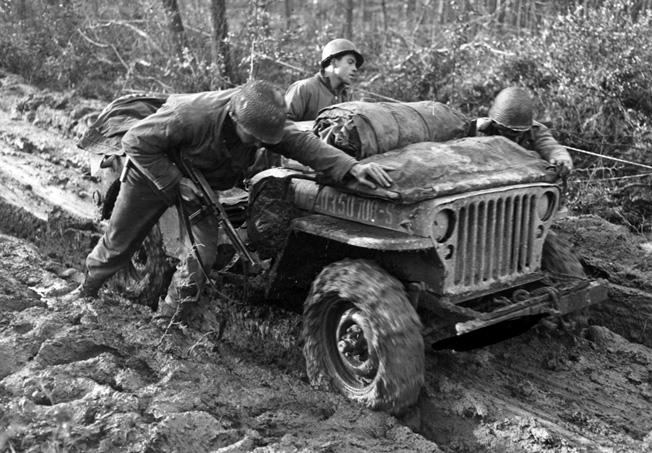
During the night, the Germans tried to slip through the Rangers' foxholes toward the bunker. The Rangers hit the small German groups with short bursts of BAR and rifle fire or grenades. A 20-minute final barrage from the American artillery drove the Germans off the hill for the fifth and final time. The German attacks had all been directed at D, E, and F Companies and had inflicted severe casualties on the Rangers. However, the Rangers held with sheer guts and accurate artillery support.
The Hürtgen Forest Campaign Concludes
By nightfall on December 8, General Weaver had juggled the lines of the 13th Infantry Regiment and was able to free up a battalion. Trucked to Hill 400, the infantrymen shuffled up the slope to the crest during the night. The Rangers were finally relieved. During 40 hours of intense fighting, the 2nd Ranger Battalion had lost 107 men wounded, 19 killed, and four missing, a quarter of their original strength. But the Rangers had seized Hill 400, the first American unit to do so in the four-month battle.
Unfortunately, nine days later the Germans retook the hill from the 13th Regiment. The U.S. Army would not seize Hill 400 again until February 1945.
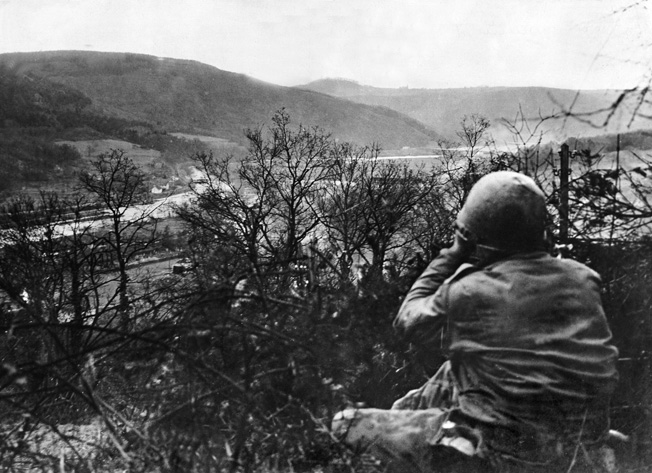
The December engagement on Hill 400 concluded the Battle of Hürtgen Forest campaign. The 2nd Rangers had demonstrated their mettle. Sid Salomon summed it up best: "The people in command did not know what the Rangers were. A Combat Command of 5th Armored Division, 3,000 men with tanks, failed to take the Burgeberg. Three companies of Rangers, just 200 soldiers, captured and held it."
lackeylacteciduch.blogspot.com
Source: https://warfarehistorynetwork.com/battle-of-hurtgen-forest-army-rangers-vs-fallschirmjagers/
Post a Comment for "Holden Sitting Up on a Hill Easy Drawing of Little Hills"